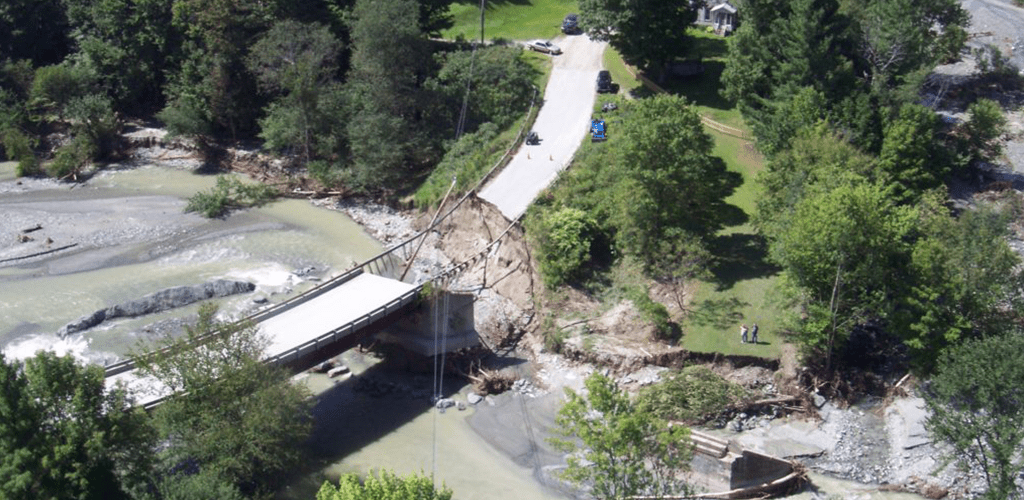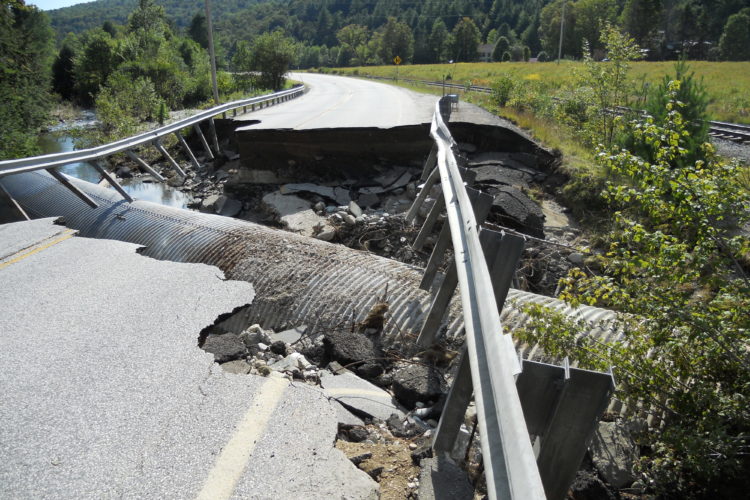We have much more to do and your continued support is needed now more than ever.
Learning From Tropical Storm Irene
This Week in NWF History

Since 1936, the National Wildlife Federation has worked to conserve the nation’s wildlife and wild places. As part of our 80th anniversary celebration, we are recognizing important moments in our history that continue to make an impact today.
As the floodwaters receded, the magnitude of the damages became exceedingly apparent. According to the Vermont Agency of Transportation (VTrans), Tropical Storm Irene left a pathway of destruction totaling $250 million in damages to transportation infrastructure alone.
Families and local businesses were also hit hard – thousands of homes and hundreds of businesses were wrecked by this single storm. More than 450 farms were impacted with over $10 million in lost or damaged crops. Important habitat within and surrounding our rivers and floodplains was also destroyed.
However, Tropical Storm Irene reaffirmed a key lesson: nature will not be controlled. We must design our infrastructure to work with – not against – natural systems.

Vermont’s rivers and floodplains were indeed stressed by the storm. Raging floodwaters displaced species, fragmented the landscape, and led to the complete loss of habitat in some areas. Stormwater runoff carried sediment and pollutants, including sewage and hazardous materials, into Vermont’s waterways – contaminating resources precious to both humans and wildlife.

In a rushed attempt to reduce flooding to surrounding areas, streambeds were excavated and their channels were widened and straightened. The increase in silt build-up and decrease in water quality, combined with these stream alteration activities, was especially damaging to fish populations. According to the VT Fish & Wildlife Department, Tropical Storm Irene wiped out between 42-67% of Vermont’s wild trout population.
Lessons Learned
Excavating streambeds doesn’t just impact fish – it also turns rivers into pipelines that rush floodwaters downstream, rather than allowing water to be absorbed in floodplains. Rivers cannot be contained by walls or deeper channels. In order to protect and safeguard our neighborhoods and communities, humans must co-exist with nature.

Tropical Storm Irene very clearly highlighted the vulnerability of man-made infrastructure. It also demonstrated the unprecedented value of healthy, intact ecosystems along our riverbanks. When properly managed, floodplains and riverbanks are capable of alleviating the impacts of flooding to adjacent and downstream communities. For instance, according to a report by the VT Agency of Natural Resources, intact floodplains and riparian habitat along the Otter Creek River reduced flooding of downstream communities by nearly 40%.
Just as a sponge soaks up a spill, these habitats mitigated the impacts of Irene by absorbing immense amounts of water. In addition to providing valuable flood protection, riparian areas naturally enhance water quality by filtering sediment and nutrients as well as maintaining cooler stream temperatures. They also serve as corridors for many of Vermont’s wildlife species to move throughout our fragmented landscape.
Five Years Later
Communities across Vermont are still recovering from the devastation. The flooding of Tropical Storm Irene was especially devastating for transportation infrastructure – washing out over 500 of miles of road and 34 bridges of the state highway system. Municipalities across the state suffered damage to over 2,000 road segments, nearly 300 bridges, and approximately 960 culverts. Unfortunately, as catastrophic as the floods of Irene were, it will not be the last time Vermont witnesses a storm of this magnitude.
As climate change is expected to result in an increased number of high-intensity rain events throughout the Northeast, the towns and villages of Vermont face the risk of more frequent and catastrophic floods in the future. While Tropical Storm Irene left a wake of destruction in its path, it also created an opportunity to create a stronger, more resilient Vermont.
Building a Resilient Future
One of the most important lessons learned from Irene is that our goals of protecting human communities and preserving the natural environment are interconnected. By managing, protecting, and restoring floodplains and riverbanks, we can drastically reduce the vulnerability of our homes, businesses, and infrastructure to flooding, while simultaneously enhancing Vermont’s beloved natural beauty and wildlife.
In a bold effort to safeguard Vermont’s connected communities from the impacts of climate change, the National Wildlife Federation’s Northeast Regional Office, the Vermont Natural Resources Council, and The Nature Conservancy, in partnership with the Staying Connected Initiative, are teaming up to ensure rivers and nearby habitats are connected and healthy across Vermont. From documenting the ways in which wildlife use these river corridors to move across the landscape to conducting public outreach on floodplain management issues, the National Wildlife Federation is working to engage Vermont communities in an appreciation of the social, economic, and environmental benefits provided by these connected corridors.
With an eye on the future, this work will help to promote climate-smart practices capable of resolving conflicts between human investments and riparian preservation in the most economically and ecologically sustainable manner possible.
Take ActionHelp the National Wildlife Federation continue our efforts of sustaining long-term resiliency for humans and natural communities of the Northeast!






















